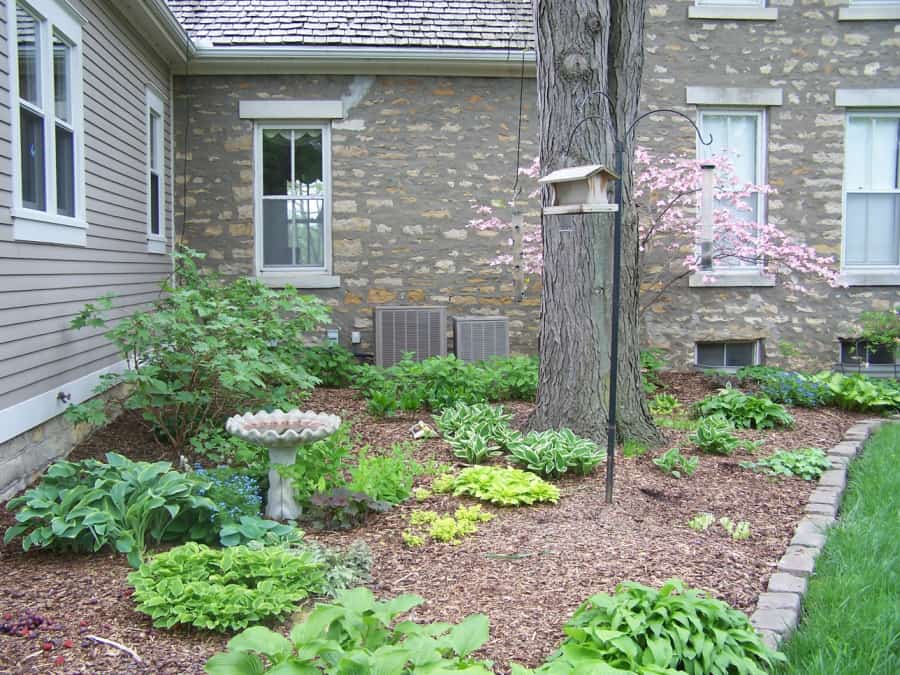Shade gardening is more than just an idea, it is a way of life for those living among the trees. When I first moved east from central Kansas, I had no idea that shade gardening would become such a big part of my everyday life. But after moving from town to town, my wife and I purchased 5 acres of abandoned farm ground edging up to a oak/hickory remnant forest.
I have worked in horticulture for a long time, and have maintained shade gardens in Manhattan and Topeka, KS. But to actually live in the woods and find native shade plants growing nearby? Amazing it is.
There is a lot that goes into shade gardening, from site selection to choosing of plants and designing beds. If you are looking to plant trees to develop a shade garden, plan on waiting at least 10 years. Unless you are planting silver maples and elms, trees take a long time to mature into the shade garden of your dreams. Work with what you have.
Shade Gardening Design
Putting together your shade garden depends on several factors. Your zone, location, type of shade you have, budget, and vision. What hardiness zone you live in plays a big factor in the types of plants you can safely grow in the garden. The gardens I design and maintain fit into zones 5 to 6a, in the Central Great Plains. This means I can safely grow plants from zones 2 to 6, though extremely cold winters may kill zone 6 plants.
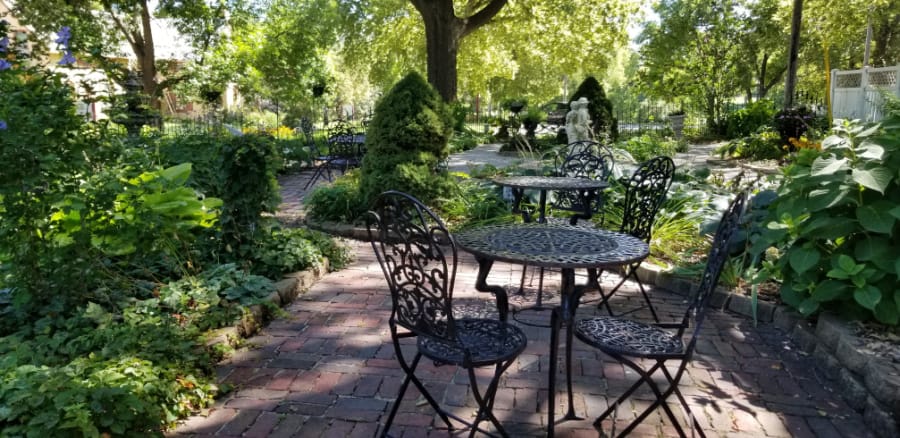
Location and Type of Shade
Your location refers to where in the overall landscape you live in. Do you live among the prairies and savannah? Or are you close to the major rivers? Maybe you are in woods like me. If you want to build a shade garden, you need to be aware of the ecosystems in play around you. This will help you pick plants and develop a maintenance plan.
Type of Shade
Do you have large, maturing oaks and other shade trees? Or do you have deep overhangs surrounded by large buildings? The type of shade you have to work with will also help determine what you can grow. There are basically 3 types of shade. Full shade, part shade, and filtered shade.
Full shade gets less than 3 hours of direct light during a summer day. This might be something on the southeast corner of the house, between the house and large shade trees. Or it could be an enclosed courtyard or atrium within the walls off a building.
Part shade recieves 3 to 6 hours of sun per day. But remember, afternoon sun is not the same as morning sun. In late afternoon in Kansas, Nebraska, Missouri, and Iowa, the sunlight is brighter and hotter than at other parts of the day. Afternoon sun should not be part of a shade garden plan.
Filtered shade can be any amount of sunlight through the day, but broken into little bits of time. These areas are usually surrounded by large, mature shade trees whose canopies do not fully touch. You will find areas like this in natural forests where glades and meadows have become grown over.
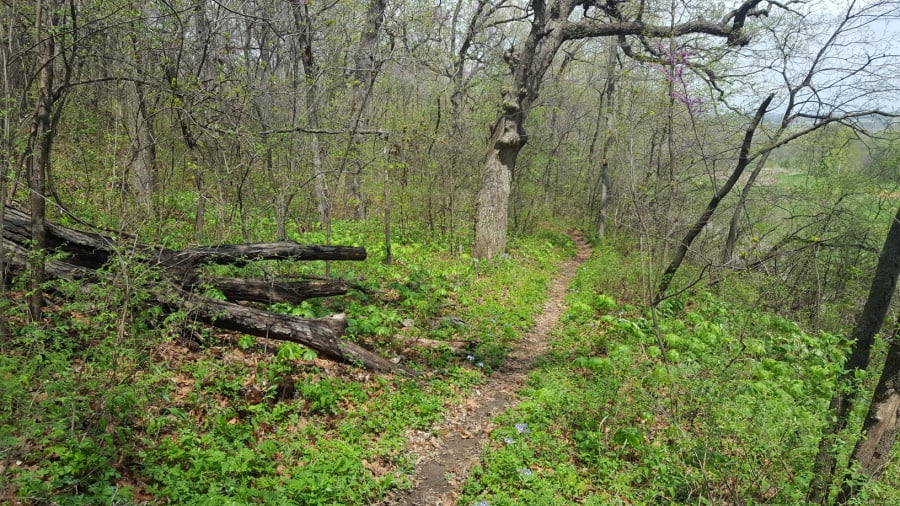
Shade Gardening Vision and Budget
Once you realize exactly what kind of shade you have and your relation to other natural ecosystems, you can begin making a vision and budget for the garden. Your vision is what types of structures, features, and plants do you want in the garden, and what kind of reward you want from it. Your budget will help determine your vision’s limitations.
Parts of the Vision
What are the parts of your shade gardening vision? Do you want to have a water feature, seating, or statuary? Would there be a gazebo or patio? Are you going to create a paradise gardening experience or do you need to work with more economical choices?
Structures
Adding structures to the garden should be done before planting. These are permanent things that will last for the majority of your time on the property. They are also the most costly things in your budget and should be planned for accordingly. I recommend that if you are getting in over your head with just this, please call Grimm’s Gardens for a consultation and design. We can help!
Structures that you may want to include when planning your garden include the following.
- Gazebo
- Pergola
- Patio
- Arbor
- Water fountain or pond
- Statuary
- Large boulders
Design Styles
There are a myriad of design styles that you may want to implement into your garden. Your garden will always be your own, because no two gardens are alike. But look into some of the following styles when developing your own plan.
- Victorian
- Cottage Garden
- Formal
- Woodland
- Japanese
- Tropical -Lush
When picking plants for some of these styles, you may need to use a lot of containerized tropicals or large annuals. This is especially true in a tropical-lush design, where the plantings will be hard to keep through the winter in colder climates.
Ground Covers for the Shade Garden
I am not talking about plants. When you are preparing your site for the incoming plants, what kind of covering are you going to use, organic mulch or inorganic? After extensive maintenance, I can tell you that using rock or some other inorganic ground cover in the shade garden is only going to cause problems with weeds.
Using an organic ground cover until the plants take over the soil surface will reduce weed pressures in the long run, and look better after cleanup. Use 3 to 6 inches of organic mulch such as sawdust, compost, or cedar to cover the ground between plantings.
Choosing Plants for Shade Gardening
This is always my favorite part of gardening-choosing plants. I am a plantsman who relishes in the choosing of plants and adding new ones to my garden. Plants make the shade, and plants make the garden glow. You should already be working with maturing shade trees (hopefully not walnut), so I will discuss understory trees, shrubs, perennials, grasses, and annuals.
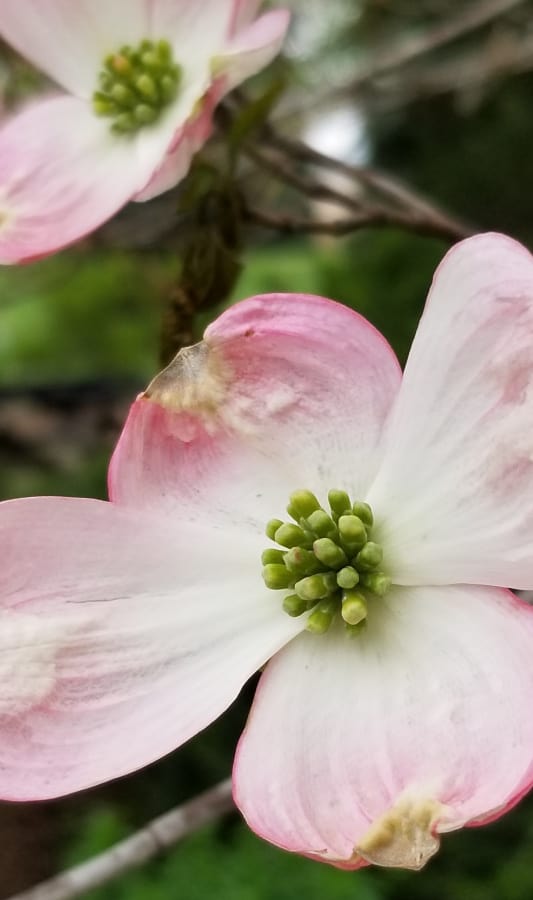
Understory Trees for Shade Gardening
Mature trees should be growing, giving shade already. They are usually 40 to 100 feet tall and have plenty of room for understory trees, which are 10 to 30 feet tall. Understory trees can also be placed on the edge of the shade garden, helping to create more space. There are 2 types of understory trees; ornamental and fruiting. While both produce fruit, the former has smaller fruits that are not readily consumed.
Ornamental Understory Trees
There are 2 subgroups of ornamental understory trees; natives and nonnatives. For the central Great Plains region, there are at least 5 nonnatives and 5 natives which you can use in your garden. The reason to use natives is that you will attract more pollinators and birds to the garden.
Natives
- Redbud – there are many cultivars available, but just a simple eastern or Oklahoma redbud will work fine.
- Flowering Dogwood – great small tree with flowers and good fall color.
- Eastern hophornbeam – This small understory tree grows wild in the woods near my home.
- Wafer-Ash – this tree is a host plant for the giant swallowtail butterfly.
- Sassafras – a good small tree with fragrant flowers and great fall color.
Nonnatives
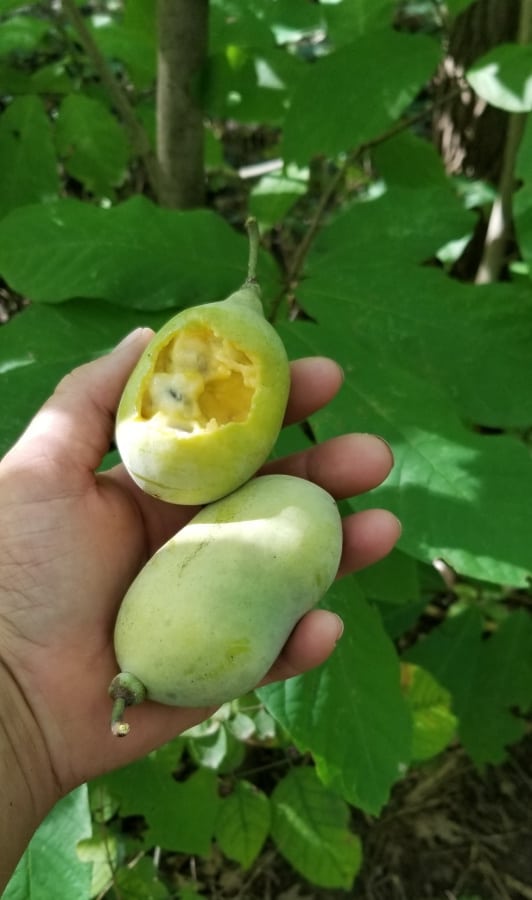
- Japanese maple – while there are not very many cultivars for our area, they are quite striking in the landscape.
- Paperbark maple – outstanding fall color and interesting bark.
- Manchurian striped maple – I have one of these in my shade garden and the flowers are gorgeous.
- Seven son tree – this smaller tree should be planted on the edge, as they need more sunlight
- Korean stewartia – very showy late summer flowers.
Fruiting Understory Trees
One does not usually think about fruiting characteristics when choosing a small tree for the shade garden. But there are a few trees that bear fruit in such conditions.
- Pawpaw – this native thicket-forming tree has delicious, tropical-like fruit.
- Serviceberry – though often planted in full sun, it will fruit well in part shade. Berries taste similar to blueberries.
- Cornelian Cherry Dogwood – yellow flowers followed by edible fruit.
Shrubs for Shade Gardening
If you are working within the confines of a natural woodland, there may already be some shrubs. However, there are a variety of showy shrubs that benefit the shade garden. There are some though that should be avoided altogether, because of their invasiveness. I will go over the invasive species to look for and avoid at the end of the plants section.
Here in the central Great Plains, there are a variety of native and some nonnative shrubs that can be planted in the shade. The following list and descriptions go over the best shrubs for shade in our area.
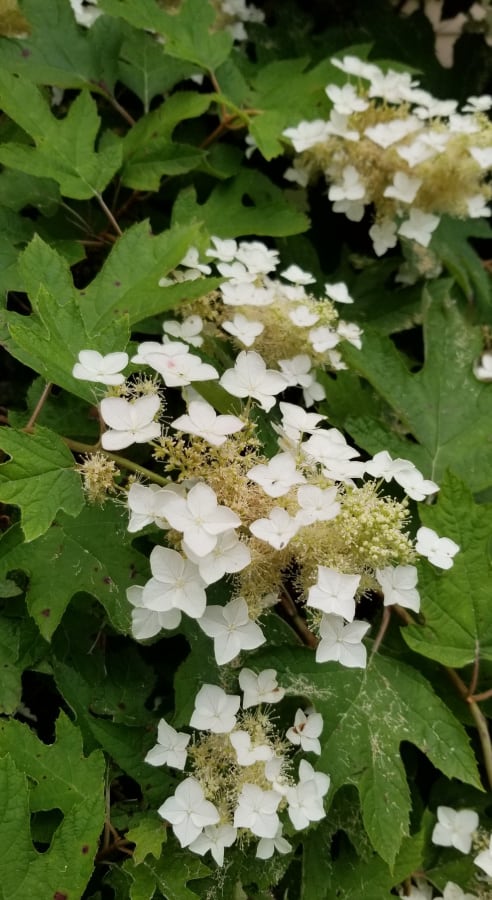
Native Shrubs
- Summersweet, Clethra alnifolia – this southeastern U.S. native blooms very well in almost full shade and has fragrant flowers. It is thicket-forming, as are many native shrubs. There are several cultivars available.
- American hazelnut, Corylus americana – has soft green leaves and a unique flower structure. The nuts are edible and the plant attracts many pollinators and birds.
- Eastern wahoo, Euonymus atropurpureus – this cousin of the invasive burning bush is a great native addition to the garden. It is a great plant for native insects and birds.
- Bottlebrush Shrub, Fothergilla major – it has unique, blue-green leaves that turn orange in autumn. The fragrant, early spring flowers are exceptional and there are several cultivars.
- Witch-hazel, Hamemelis virginiana – while there are several nonnative species and cultivars, this native variety will help build a better ecosystem and attract native insects and birds. Blooms in winter.
- Oakleaf Hydrangea, Hydrangea quercifolia – another great native with flower power and many cultivar available. Grows in full sun to full shade. Leaves turn purple in autumn. A 4-season plant.
- American Bladdernut, Staphylea trifolia – this large shrub is sometimes a small tree. Has unique seedpods and attracts many insects.
- Blackhaw Viburnum, Viburnum prunifolium – this native shrub does well in part sun and ha edible fruit. Leaves turn reddish orange in fall.
- Oregon Grape-Holly, Mahonia aquifolium – semi-evergreen, this prickly, holly-like shrub has fragrant yellow flowers in spring.
- Leatherwood, Dirca palustris – this little-known native shrub will grow in deep, filtered shade. Blooms very early in spring.
- Prickly-ash, Zanthoxylum americanum – Another host for the giant swallowtail butterfly, this shrub prefers filtered shade.
Nonnative Shrubs
- Japanese spikenard, Aralia cordata – 2020’s Perennial Plant of the Year was the cultivar ‘Sun King’. Outstanding yellow foliage.
- Japanese rose, Kerria japonica – this multi-stemmed shrub has bright yellow flowers on bright green stems.
- Boxwood, Buxus species – there are many species and cultivars of boxwoods available in the market. They prefer part shade in our area. Great for formal gardens.
Perennials for Shade Gardening
This list can go on and on and on. There are hundreds of perennials, and hundreds more of cultivars. Of just hostas, there are over 6000 registered cultivars. It can be daunting to choose varieties, let alone species to plant. Choose a mixture from the following lists of plants for shade; native perennials, nonnative perennials, groundcovers.
Native Perennials for Shade
I love mixing and matching these into my garden, along with my favorite nonnatives. I am by no means a purist when it comes to plants; rather I look to see what is most adaptable to my site and conditions.
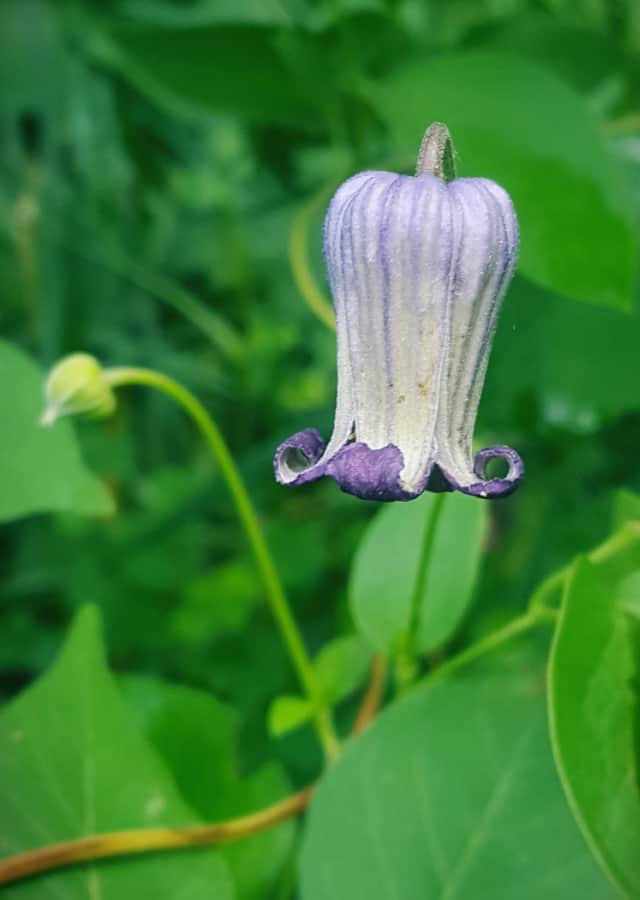
- Jack-in-the-Pulpit
- White snakeroot, Ageratina altissima
- Sweet Joe Pye, Eupatorium purpureum
- Hairy Sunflower, Helianthus hirsutus
- Drummond’s Aster, Symphyotrichum drummondii
- Starry Campion, Silene stellata
- Large-flowered Tickclover, Hylodesmum glutinosum
- Dutchman’s breeches, Dicentra cucullaria
- Solomon’s Seal, Polygonatum biflorum
- Wood Poppy, Stylophorum diphyllum
- Blue Wood Phlox, Phlox divaricata
- Red Columbine, Aquilegia canadensis
- Pitcher’s Clematis, Clematis pitcheri
- Shooting Star, Dodecatheon meadii
- Maryland Figwort, Scrophularia marilandica
- Coral Bells, Heuchera species
- Foamflower, Tiarella cordifolia
- Virginia Stickseed, Hackelia virginiana
Nonnative Perennials for Shade
This is the list where you find your normal sounding shade plants. I am sure many of you have not heard of most of the above perennials for the shade garden, but I hope you will seek them out. They are quite wonderful.
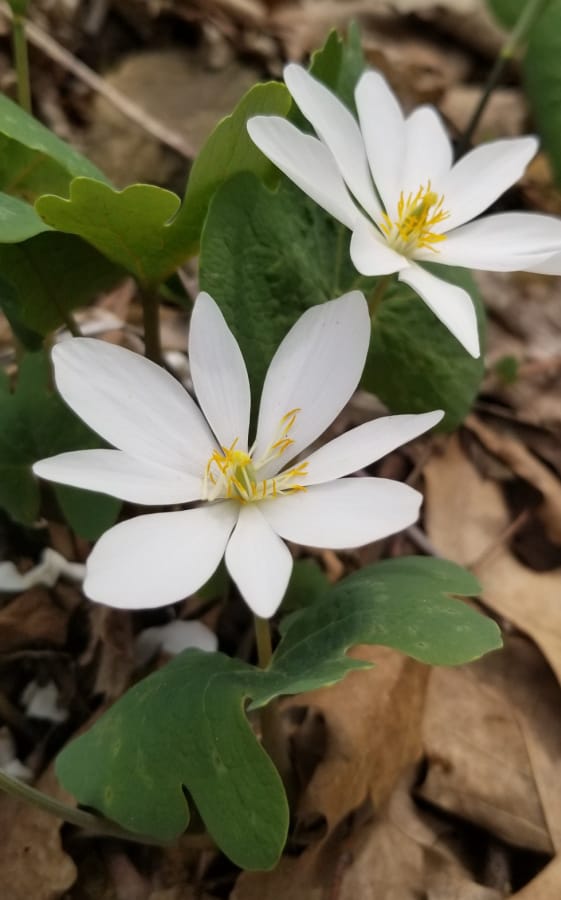
- Japanese anemone
- Pigsqueak, Bergenia
- Brunnera
- Bleeding hearts
- Epimedium
- Japanese Painted Fern
- Lenten rose, Helleborus
- Hosta
- Ligularia
- Pulmonaria
- Toad Lily, Tricyrtis
Groundcovers for Shade
This is a mix of native and non-native groundcovers. Most groundcovers are fairly aggressive, but these are selected for their slightly meeker natures. Use them with the above perennials for a cohesive look.
- Wild ginger, Asarum canadense
- Mayflower, Podophyllum peltatum
- Virginia Waterleaf, Hydrophyllum virginianum
- Bloodroot, Sanguinaria canadensis
- Goat’s Beard, Aruncus dioicus
- Carpet Bugle, Ajuga reptans
- Japanese spurge, Pachysandra terminalis
Grasses and Sedges for Shade Gardening
While I am not talking about lawns for shade, ornamental grasses can be successfully used. Many people do want to know how to have a lawn in the shade, but it can never. At least not in our area. You might get away with a sedge lawn, but not a grass lawn. However, many grasses and sedges can be used to border and accent other perennials and shrubs in the shade.
Sedges are not true grasses, but rather, grass-like plants. There are over 500 species of sedges in North America, 78 of which are native in our area. They grow in a variety of locations, from wetlands to prairies to desert to forest. And many can be useful in our gardens.
Grasses for Shade
While you can find more information about the native grasses for shade in the post Using Native Grasses in the Landscape, I will list them here. Also included in the list are some nonnative grasses for shady spots.
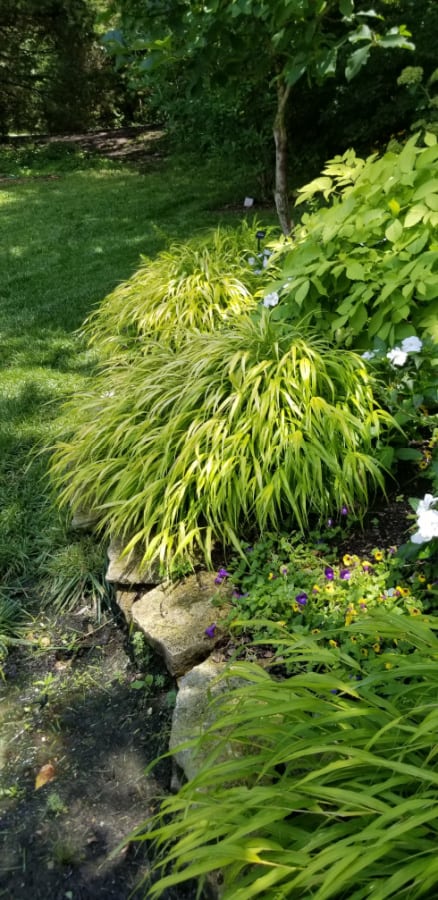
- Northern Sea Oats, Chasmanthium latifolium
- Bottlebrush Grass, Elymus hysterix
- Canada Wild-Rye, Elymus canadensis
- Japanese Forest Grass, Hakonechloa macra
Sedges for Shade
Wait, is that all the grasses for shade? Yep, that is it, at least for our area. I have a little longer of a list for sedges, but when it comes to shade, better look for perennials.
- Woodland sedge, Carex blanda
- Cedar sedge, Carex eburnea
- White-Tinged sedge, Carex albicans
- Texas sedge, Carex texensis
- Frank’s Sedge, Carex frankii
- Pennsylvania sedge, Carex pennsylvanica
- ‘Blue Zinger’ sedge, Carex flacca
Annuals for Shade Gardening
I always like to includes some subtropical annuals in my shade garden beds. They are fillers for those spaces that you want filled in fast, but know that the groundcovers cannot grow 6 feet a year. Annuals also provide season long pops of color where perennials cannot.
Annuals
- Impatiens walleriana
- Impatiens pallida
- Caladiums
- Impatiens capensis
- Coleus cultivars
- Begonia cultivars
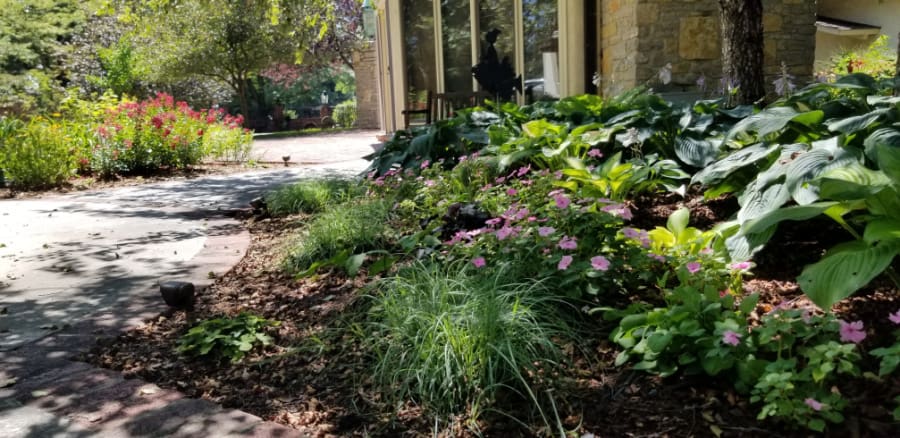
Shade Gardening Maintenance
Now that you have designed, planned, and hopefully put together your shade garden, it is time to think about maintaining it. Care of the garden begins with knowing what are desirable plants and what are weeds. Weeds are any plant that does not belong where it is. A hosta could be a weed in a meadow garden.
If you picked and planted the garden yourself, you should be able to tell the difference between weeds and wants. I find working in the shade garden much more enjoyable, because I am protected from the sun. For tools, get a good scuffle hoe, soil knife, pruners, and barrel to put trimmings into.
If your shade garden is a woodland or cottage garden style, cleanup in spring or fall can be minimal, as we want leaves to be part of the ecosystem.
Cleanup in Shade Garden
Autumn is generally time to cleanup the garden, at least in part. I spend most of my fall maintenance actually raking leaves off the lawn. But there are a few shade garden plants that are better cleaned up in the fall than in spring. Hostas for instance, are messy if left until spring, so I cut these back after the first hard freeze.
Spring cleanup consists of blowing or raking out leaves that have piled up against plants. This something that rarely happens in the woodlands, because we humans like to have more plants in a space than is natural, at least in the shade. If you must cleanup the garden, use shears to cut down plants, then rake them up and remove them to the compost pile.
Also, spring is the time to apply mulch in areas where it may have broken down or washed away. If you are having trouble with mulch washing away from a spot, maybe change the area to a boulder field or dry streambed. Another addition to the garden are nurse logs, which can be used to stop wash-outs and will provide a safe place for insects to overwinter.
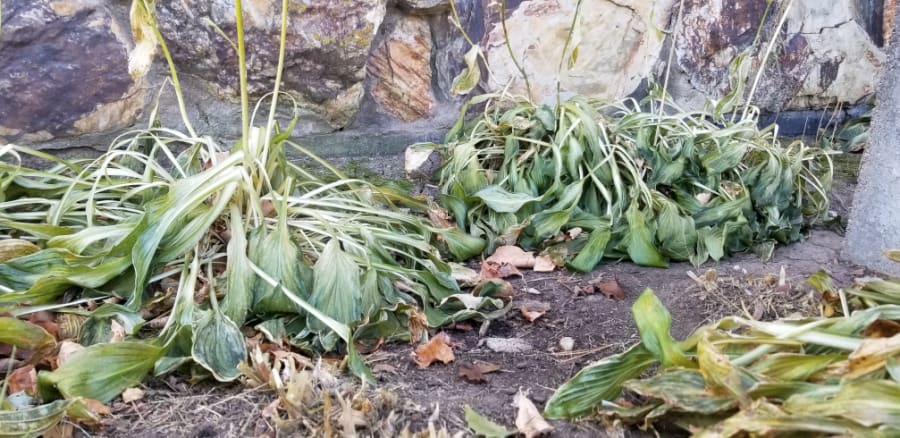
Changes in the Garden
One of the things to remember is that several of your plants could be ephemeral. This means that they come up early and bloom, then most of the leaves die by summer, and the seedheads emerge in autumn. Jack-in-the-Pulpit, Dutchman’s breeches, and shooting stars are examples of ephemerals. Try to remember where you planted these, so you do not plant anything else there after thinking, “Hmm… I thought there was something there.”
Over time, some plants may get too large and need to be removed, rejuvenated, or divided up. Shrubs and understory trees will likely need some light pruning each year to keep them from overcrowding their neighbors. However, it is okay to have a full garden, with lots of plants. It is better for the wildlife.
Perennials, grasses, and sedges will likely need to be divided every 5 to 10 years. The sedges will actually start encroaching on some of the perennial plants if you let them, so get a good soil knife to keep them back.
Conclusion
Remember this if nothing else, the garden is a living, breathing entity that can sustain itself if the correct mix of native to nonnative is found. So find it.
Happy planting!

